By R.K. Campbell | Contributing Editor

This is the standard buckhorn sighted Henry rifle. This one is color case hardened.
Henry has supplied us with excellent quality .22 rifles at a fair price for some time. These lever-action rifles are made in America and priced so that working folks can afford them. Henry offers a diverse number of rifles but they are best known for lever-action models. They offer distinctively styled rifles in calibers from .22 to .45 Colt. Henry offers stainless steel, blue, case hardened and brass frame rifles.
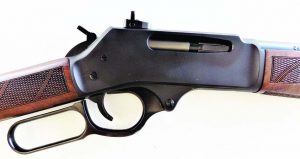
Fit and finish of the Henry rifle are excellent.
One of my favorites is the .30-30 version. This rifle features a round 20-inch barrel, blue receiver and barrel, and surprisingly attractive wood stocks. There are other models to choose from but the rifle I chose is perfectly suited to my needs and abilities. The sights were the selling point. My rifle is fitted with a set of XS Express Sights. They consist of a bold front post and an open aperture rear sight. These sights are brilliantly fast at moderate range and offer a degree of accuracy to 100 yards. While the standard buckhorn sights may be more accurate at long range I can no longer see these sights and use them well. The aperture sight is ideal for my use. This system may be fitted to other lever-action rifles but I am glad Henry chose to include XS sights as a feature on some of their rifles.
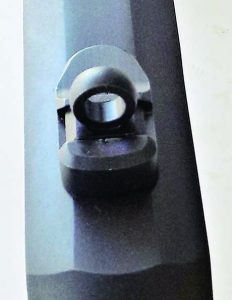
The author appreciates the XS peep sight.
When you handle a Henry rifle you have a rifle that is sturdy and well made of good material. The flat top receiver would allow the mounting of a scope, if desired. That’s fine for some types of hunting but I prefer the aperture type sights for my use. Deer and boar at 50-100 yards will fall to those that practice. The rifle looks similar to the various pistol caliber carbines offered by Henry. The receiver, however, is longer due to the need to handle the .30-30 Winchester cartridge. The fit and finish of the rifle are good. The wooden furniture fits the receiver and barrel well. The bolt locks up tight in the receiver. When you use this rifle be certain to push the lever forward, not down, like any lever action rifle and you will have real speed and smoothness with practice. Back to the wood: this is nicely grained American walnut and the finish is excellent. The stock features a hard rubber butt pad. The .30-30 WCF isn’t a hard kicker but this recoil pad is a welcome addition.
No loading port
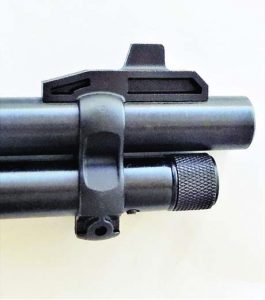
The Henry’s bold front post makes for good shooting.
The 20-inch barrel is round. Octagonal barrels are available on certain types of rifles. This is a fairly heavy barrel at .85 inch diameter. The barrel features a recessed crown. Unlike most lever action rifles the Henry doesn’t use a loading port in the receiver. The rifle is loaded in the same fashion as the other Henry rifles, from .22s to the .45 Colt.
There is a magazine under the barrel like most lever action rifles. A brass inner tube is twisted about a quarter turn and removed or moved to the loading position in order to load the rifle. A large cut out allows loading the magazine. The magazine has a capacity of six cartridges. The only drawback to this system is that the rifle cannot be topped off with a round or two in the manner others may, but this will not be important in a hunting situation and should not be important in most defensive situations. My rifle is a truck gun, carried in a padded case and ready to deal with game of opportunity or coyote and other dangerous threats.
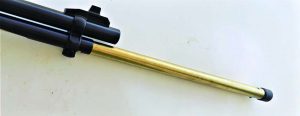
The Henry’s inner magazine tube is pulled forward to load the magazine.
The Henry rifle is a simple rifle with a proven action that works smoothly and with good leverage. An extension of the lever butts into the bolt and keeps it locked in place. The rifle features a transfer bar system, a nice modern addition to the lever-action design. The trigger must be fully depressed in order for the firing pin to properly line up with the cartridge primer. There is no half-cock notch and none of the obtrusive looking safeties found on modern lever action rifles. Cock the hammer or lever a cartridge into the chamber and you are good to go.
.30-30 WCF performance
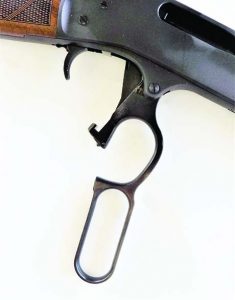
Henry’s lever offers plenty of leverage.
The original .30-30 Winchester Center Fire loading was a 160-grain bullet at 1,970 fps. Over the years the standard loading was changed to a 150-grain JSP at 2,390 fps or a 170-grain bullet at 2,200 fps. From a 20-inch barrel most of these loads generate less velocity. However, velocity is respectable for a short range deer slayer. Here are ballistics from the Henry rifle.
Hornady 160-gr. LEVERevolution 2,330 fps
Remington 150-gr. Core Lokt 2,268 fps
Winchester 170-gr. Power Point 2,155 fps
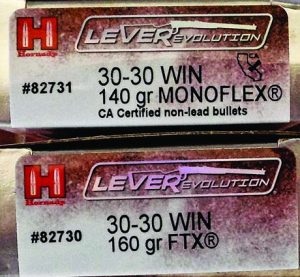
Hornady offers a good range of .30-30 WCF ammunition. Both the MonoFlex and LEVERevolution bullets offer a soft tip for safety when loaded in a tubular magazine.
Hornady developed the LEVERevolution line in order to allow the safe use of a pointed bullet with much better ballistics in a lever action magazine. A tubular magazine places the bullet nose against the primer of the cartridge ahead. Pointed bullets cannot be used or they may cause an explosion in the magazine. I have loaded the .30-30 with high performance spitzer bullets many years ago but kept only one cartridge in the magazine and one in the chamber—not ideal! The LEVERevolution is a neat solution to the problem. If you handload you will be able to best factory loads using 150- to 170-grain bullets by about 100 fps. Be careful as always in working these loads up.
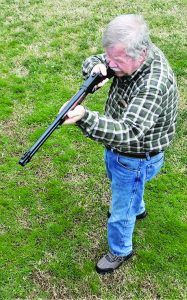
The Henry is well balanced and points well. The author found the Henry’s action smooth in operation.
Another option for handloaders is also available in a 140-grain bullet in .308 diameter. The MonoFlex combines the solid copper GMX and the FTX tipped bullet into a bullet that is suited for hunting and for use in a tubular magazine. The result is a bullet that will retain ninety five per cent of its weight when recovered. This alloy doesn’t foul or increase pressure as some may.
Firing for accuracy I limited my shots to 50 yards. The XS sights are all about speed at moderate range. The rifle’s accuracy potential is there, the shooter is limited. I fired from a solid benchrest using the LEVERevolution load, firing three-shot groups. While the 1¾ inch group was something to brag about the average groups were 2 inches. That is plenty for defensive use and for taking game in woods distances. The Henry rifle is pure class, works as designed, and offers good utility. That is all we may ask.



